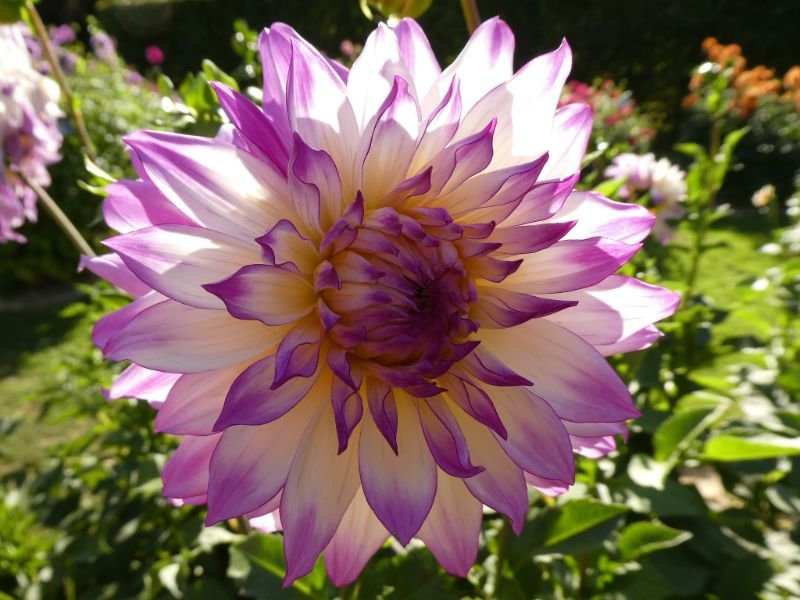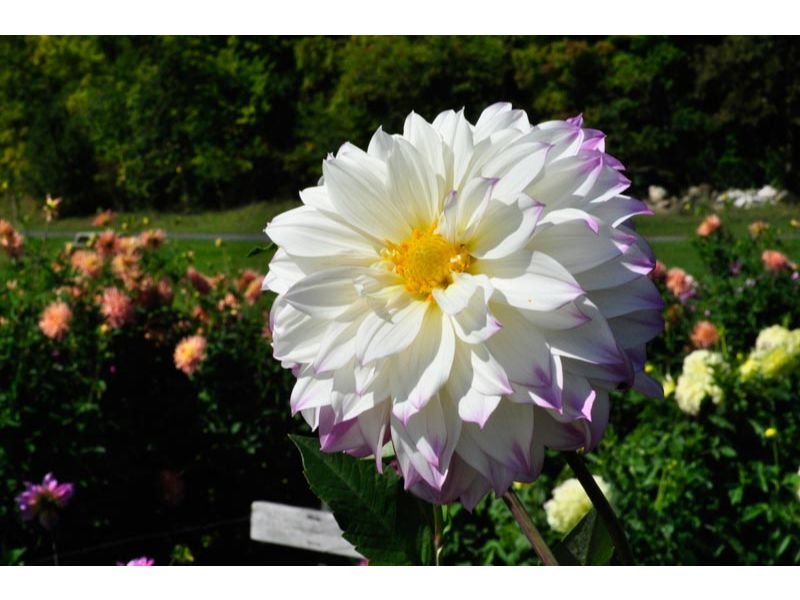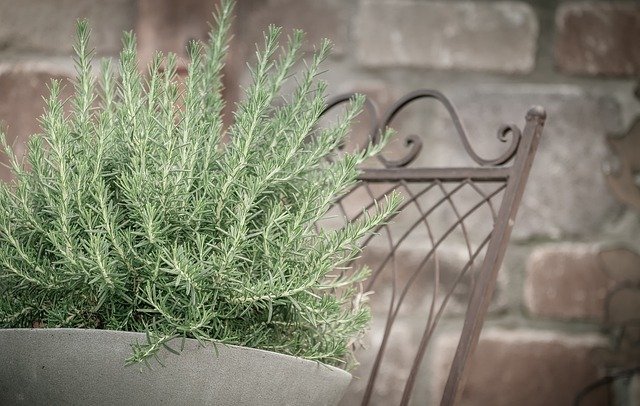Dahlia Ferncliff Illusion is a type of Dahlia that was developed in the UK. It is a result of crossing two Dahlia varieties, ‘Ferncliff’ and ‘Dahlia’. The resulting plant has fern-like leaves and blooms that are pink, white, or yellow in color. Dahlia Ferncliff Illusion is a popular choice for gardens and bouquets due to its unique appearance.

The plant is also relatively drought-tolerant. Dahlias are typically low-maintenance plants, but Dahlia Ferncliff Illusion does require deadheading (removing spent blooms) to promote continued flowering throughout the season.
Table of Contents
Condition Requirement for Dahlia Ferncliff Illusion to thrive.
Dahlia Ferncliff Illusion is a popular choice for gardeners who want to add a touch of elegance to their landscape. This beautiful Dahlia variety has large, showy blooms in a range of colors, making it a real standout in the garden.
However, Dahlia Ferncliff Illusion is not without its challenges. In order to thrive, this Dahlia requires consistent moisture and relatively high humidity levels.
Additionally, it is important to protect Dahlia Ferncliff Illusion from strong winds, as the delicate blooms can be easily damaged.
In order to maximize your Ferncliff Illusion growth, there are some growth requirements that need to meet:

Hardiness
Dahlia Ferncliff Illusion is a beautiful perennial that is perfect for adding a touch of elegance to any garden. This Dahlia variety is known for its striking white flowers which have a delicate fern-like appearance.
While the Ferncliff Dahlia is relatively easy to care for, it does have some specific hardiness requirements that must be met in order for it to thrive. This Dahlia variety is best suited for USDA hardiness zones 8-10 and prefers full sun to partial shade.
If you live outside the ideal gardening zone, don’t worry as you can still grow this plant with some tricks. Two of the main factors for Dahlia Ferncliff to thrive are the amount of sunlight it can get and the ideal soil conditions. let’s dive into each of them.
Sunlight
In order to thrive, Dahlia Ferncliff Illusion needs at least six hours of sunlight per day. The morning sun is best, as the afternoon sun can cause the flowers to fade.
When planting this Dahlia, be sure to place it in an area that receives plenty of sun throughout the day. This will ensure your plant survives in any gardening condition or even in containers.
Soil
This Dahlia requires a well-draining soil mix that is high in nutrients. The best way to achieve this is by using a mix of compost, peat moss, and sand. This mix will provide the Dahlia with the nutrients it needs to thrive while also allowing the roots to get the oxygen they need.
Dahlia Ferncliff Illusion Care Guide
Dahlias are one of the most popular flowers in the world. They come in a wide variety of colors, shapes, and sizes, and they’re easy to grow. If you’re looking for a beautiful flower for your garden, then you should consider growing Dahlia Ferncliff Illusion.
Growing Dahlias is easy and Ferncliff Illusion is a great choice for beginners. Here is a care guide to getting you started.
Planting
planting Dahlia Ferncliff Illusion is best done in the spring after all danger of frost has passed. The plant requires full sun and well-drained soil. To ensure that the soil drains properly, mix in some sand or pebbles. Dahlias should be spaced about 18 inches apart to allow for proper growth. When planting, dig a hole that is twice as big as the root ball. Gently loosen the roots and place the plant in the hole, making sure that the crown is level with the soil surface. After planting, water generously and apply a layer of mulch to help retain moisture.
Water
If you’re thinking of planting Dahlia Ferncliff Illusion in your garden, you’re probably wondering how much water they need and when the best time to water them is. Luckily, they’re not too difficult to care for in terms of watering. They should be watered about once a week, and the best time to water them is in the morning so that the leaves have time to dry before nightfall. Be sure to check the soil before watering, as Dahlia Ferncliff Illusion does not like to be overwatered. If the soil is still moist from the last watering, you can wait another day or two before watering again.
Fertilizer
One important aspect of dahlia care is fertilization. Dahlias need a steady supply of nutrients to produce an abundance of flowers, so it’s important to use a fertilizer that is high in phosphorus. An application every four to six weeks should be sufficient. However, you may need to adjust the frequency depending on the type of soil you have and the amount of rain you get. Overfertilization can cause problems, so it’s always best to err on the side of caution.
Pruning
Dahlia Ferncliff Illusion is a beautiful and unique plant that can add interest to any garden. However, it’s important to prune it properly in order to keep it healthy and encourage new growth.
Start by deadheading the plant, which means removing any spent flowers. Wait until the plant is dormant—usually in late winter or early spring. This will help ensure that you don’t damage any new growth.
Next, use sharp, clean shears to remove any dead or damaged leaves or stems.
Next, cut back the stems by about one-third. This will encourage the plant to produce new growth.
Finally, shape the plant by trimming off any stray leaves or branches. This will encourage new growth and prevent the plant from becoming overcrowded.
Harvest
The Dahlia Ferncliff Illusion is a beautiful flower that can add a touch of elegance to any garden. This variety of dahlia is known for its delicate petals and stunning colors.

The Ferncliff Illusion is a great choice for cut flowers, and it also makes a beautiful addition to any bouquet.
If you are interested in harvesting your own Dahlia Ferncliff Illusion, it is important to know when the flowers are ready to be picked.
The best time to harvest these flowers is when they are fully open and the petals are starting to drop. Once you have cut the flowers, you can enjoy their beauty indoors or use them to create a beautiful arrangement.
Propagation
Dahlia Ferncliff Illusion is a rhizomatous plant that can be easily propagated through division.
- The best time to divide the plant is in early spring before new growth begins.
- To divide the plant, dig up the entire clump and carefully pull it apart into smaller sections.
- Each section should have at least one eye or growing point. Plant the sections in moist soil and water them well.
- Keep the soil moist until new growth appears, then reduce watering to once a week.
- Ferncliff Illusion will bloom in late summer to early fall and can be propagated indefinitely through division.
Seasonal Precautions
As the weather begins to cool and the days grow shorter, gardeners must take special care of their plants to ensure that they remain healthy through the winter. One plant that requires special attention is the dahlia Ferncliff illusion.
This delicate flower is sensitive to frost and can easily be damaged by cold weather. As a result, it is important to take precautions when the first frost of the season is forecast.
Gardeners should cover their dahlias with a layer of mulch or straw, and if possible, move them indoors to a sheltered location.
Common Problems Dahlia Ferncliff Illusion

Why are my Dahlia buds turning brown?
One of the most common problems gardeners face is browning Dahlia buds.
There are a number of possible reasons for this, but the most likely culprit is a lack of water. Dahlias need to be well-hydrated to produce healthy blooms, so make sure to water your plants regularly, especially during hot weather.
Another possibility is that the buds are being damaged by too much fertilizer. Too much nitrogen can cause bud-blasting, so it’s important to use a balanced fertilizer and avoid over-fertilizing.
Finally, Dahlias are susceptible to a number of fungal diseases, which can cause the buds to turn brown and drop off. If you suspect your plants are infected, remove any affected buds and dispose of them carefully.
How do you revive dahlias?
If your dahlias have started to look a bit tired, there are several things you can do to revive them.
For starters, make sure they’re getting enough water. Dahlias need about an inch of water per week, so be sure to give them a deep soaking if the weather has been particularly hot or dry.
In addition, fertilize your dahlias every few weeks to help them stay healthy and vigorous. You can also remove any spent blooms to encourage the plant to produce more flowers. With a little TLC, your dahlias will soon be looking their best.
Why are my dahlias growing slowly?
If you’re wondering why your dahlias are growing slowly, there could be a few reasons.
One possibility is that they’re not getting enough sunlight. Dahlias need at least six hours of sunlight per day, so if they’re not getting that much, they may not be growing as quickly as they could be.
Another possibility is that the soil isn’t nutrient-rich enough. Dahlias need plenty of nutrients to grow well, so if the soil is lacking in those, the plants may not be able to reach their full potential.
Finally, it could simply be that the plants are still young and haven’t reached their mature growth yet. If you give them a little time, they should start to grow more quickly.
Why are my dahlias not growing?
Stunted dahlias are a common problem, but there are a few possible explanations.
One possibility is that the roots are too crowded. When dahlias are planted too close together, they compete for water and nutrients, which can inhibit growth.
Another possibility is that the plants are not receiving enough sunlight. Dahlias need at least six hours of sunlight per day in order to thrive.
Finally, it is also possible that the plants are not getting enough water. During hot, dry weather, dahlias need to be watered deeply and regularly in order to prevent stress.
If your dahlias are still not growing well, it is best to consult with a local nursery or extension service for more specific advice.
Common Pests and Diseases Dahlia Ferncliff Illusion
Dahlias are beautiful, vibrant flowers that add a splash of color to any garden. Unfortunately, they are also susceptible to a number of common pests and diseases.
One of the most common problems is powdery mildew, which appears as a white powder on the leaves and stems. If left untreated, it can cause the leaves to turn yellow and eventually drop off.
Aphids are another common pest, and these tiny creatures can quickly devastate a dahlia plant. They suck the sap from the leaves, causing them to turn yellow and curl up. In severe cases, aphids can even cause the plant to wilt and die.
Finally, dahlias are also susceptible to root rot, which can occur if the plant is grown in waterlogged soil. Symptoms include yellowing leaves, stunted growth, and eventually death.
Luckily, there are a number of ways to prevent and treat these problems. Regular watering, good air circulation, and proper fertilization can help to keep dahlias healthy and disease-free.

Gardening is my passion and growing plants indoors has always been a stress relief for me. Grow a banana tree in my apartment once (although failed to produce bananas).






